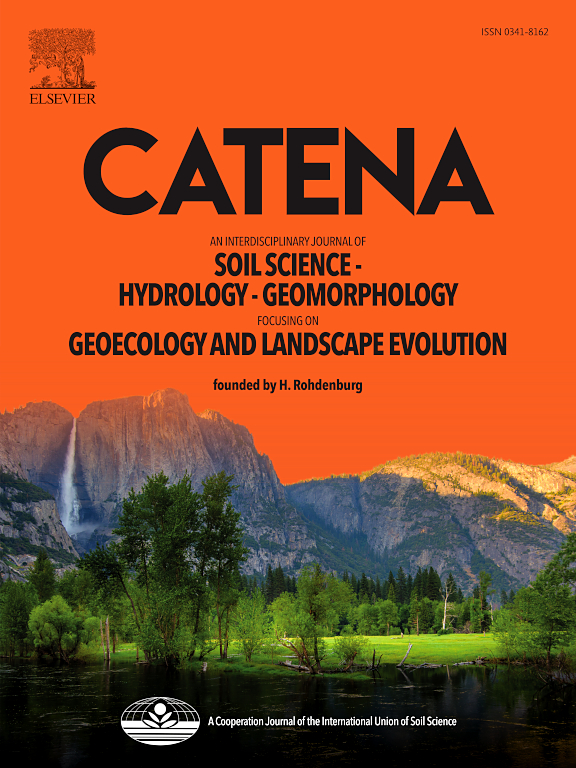半干旱至干旱气候降水梯度中的槽头形态测定
IF 5.7
1区 农林科学
Q1 GEOSCIENCES, MULTIDISCIPLINARY
引用次数: 0
摘要
了解水头分布及其决定因素可以提高对排水系统发展的认识,但大多数研究都集中在潮湿气候上。因此,本研究调查了以色列内盖夫沙漠从半干旱(370毫米)到干旱(90毫米)气候的降水梯度上的水道头的发展。重点是了解影响水道头分布和形态的因素,特别是降水和基岩性质的作用。基于对100个水头的详细现场测量,利用主成分分析(PCA)和方差分析(ANOVA)对水头上方和水头内部的局部坡度、水头切口长度和水头底部等形态计量参数以及贡献区域参数进行了分析。结果表明,河槽头的形成受气候和地质因素的双重影响。在降水较多的地区,沟道头越深越长,而在基岩抗侵蚀的地区,沟道头贡献面积越大,坡度越陡。该研究确定了驱动水道头发育的三个主要因素:贡献区域的大小和形状(主要受基岩岩性影响)、当地坡度和降水量。反映排水密度的水头密度与基岩硬度呈强负相关(r = -0.69),与降雨频率呈弱负相关(r = -0.27和r = -0.25);10 mm d-1与降水侵蚀力的关系,与植被覆盖度的关系非常弱(r = -0.15)。坡面积关系分析表明,在半干旱气候条件下,沟道头一般位于河谷系统的最上层,而在干旱区,沟道头既位于河谷的山坡上,也位于河谷的过渡段。该研究为干旱环境下的土地和水资源管理策略提供了重要见解,强调了气候条件和地质特征在形成排水网络方面的复杂相互作用。本文章由计算机程序翻译,如有差异,请以英文原文为准。
Channel head morphometry in the precipitation gradient from semi-arid to arid climates
Understanding channel head distribution and its determinants enhances knowledge of drainage system development, but most studies focus on humid climates. Therefore, this study investigates the development of channel heads across a precipitation gradient from semi-arid (370 mm) to arid (90 mm) climates in the Negev Desert, Israel. It focuses on understanding the factors influencing channel head distribution and morphometry, specifically the roles of precipitation and bedrock properties. Based on detailed field measurements of 100 channel heads, morphometric parameters such as local slope gradients above and within channel heads, lengths of headcuts and channel heads bottoms, parameters of the contributing area were analyzed using Principal Components Analysis (PCA) and Analysis of Variance (ANOVA). The results indicated that channel head formation was significantly influenced by both climatic and geological factors. In areas with higher precipitation, channel heads were deeper and more elongated, while areas with erosion-resistant bedrock exhibited larger contributing areas and steeper slopes. The study identified three main factors driving channel head development: the size and shape of contributing areas (primarily affected by bedrock lithology), local slope gradients, and the amount of precipitation. Channel head density, reflecting drainage density, showed a strong negative relationship (r = -0.69) with bedrock hardness, a weak relationship (r = -0.27 and r = -0.25) with frequency of rainfall > 10 mm d-1 and erosivity of precipitation, and a very weak relationship (r = -0.15) with vegetation cover. The slope-area relationship analysis revealed that channel heads were generally located in the uppermost sections of the valley system in semi-arid climates, while in arid areas, they occurred in both the hillslopes and transition sections of the valley. The study provided crucial insights for land and water management strategies in arid environments, emphasizing the complex interplay between climatic conditions and geological characteristics in shaping the drainage network.
求助全文
通过发布文献求助,成功后即可免费获取论文全文。
去求助
来源期刊

Catena
环境科学-地球科学综合
CiteScore
10.50
自引率
9.70%
发文量
816
审稿时长
54 days
期刊介绍:
Catena publishes papers describing original field and laboratory investigations and reviews on geoecology and landscape evolution with emphasis on interdisciplinary aspects of soil science, hydrology and geomorphology. It aims to disseminate new knowledge and foster better understanding of the physical environment, of evolutionary sequences that have resulted in past and current landscapes, and of the natural processes that are likely to determine the fate of our terrestrial environment.
Papers within any one of the above topics are welcome provided they are of sufficiently wide interest and relevance.
 求助内容:
求助内容: 应助结果提醒方式:
应助结果提醒方式:


